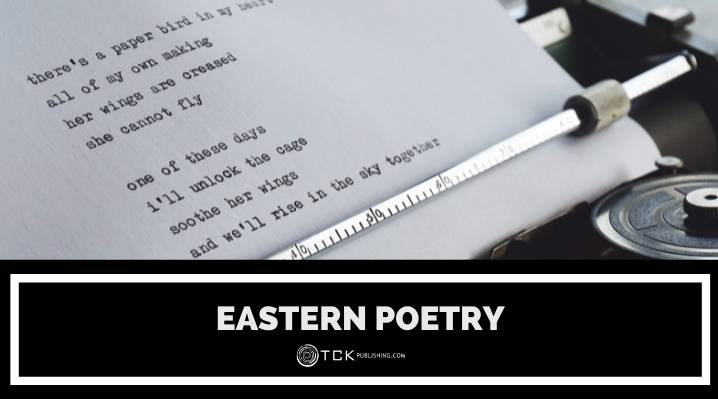
Poetry has always been a popular outlet in literature. Whether you’re a writer or a reader, you’ve surely appreciated some pieces of poetry.
I remember sitting down in a stuffy room as my high school teacher droned on about what Edgar Allan Poe’s “The Raven” meant (don’t ask me though, I’ve forgotten all about it), or that time my college instructor made us memorize Edmund Spencer’s “Amoretti XXX.”
My education and my personal interest in literature have introduced me to the sonnets of William Shakespeare, the limericks of Edward Lear, the epics of Homer, and many more works by famous poets. It’s made me realize that most poetry I know is of the Western sort.
That made me wonder about other poetry forms and types, specifically ones that are of Eastern origins, so I’ve decided to check some out and share my findings with you.
Eastern Poetry Types
Basic education in English and literature has introduced us to the sonnet, the ode, the elegy, the limerick, and other poetic forms.
Most of these are predominantly western types of poetry. They follow western ideals, conventions, and influences. But there’s still an entire hemisphere’s worth of literature to scour for new poetic types and forms.
And when it comes to Eastern poetry, most people are only familiar with haiku, but the East has a lot more to offer than just that.
When I say “East,” I’m not just talking about poetry with Asian roots, but also Africa, the Pacific, and some parts of Europe.
Below are lesser-known poetry forms of Eastern origin and their examples. I’ve done my best to find English translations that follow the intended structure and rhyme pattern.
1. Sijo
The Sijo is a traditional poetic form from Korea that emerged in the Goryeo period (which started in 918) and is still practiced today.
It’s composed of three lines with a major pause at the half of each. Each line is typically 14-16 syllables long, with the entire poem at 42-48 syllables. A Sijo can be thematic, with the first line introducing a situation, the second a development of the situation, and the third, a twist and conclusion.
Here’s a sijo by a kisaeng (similar to a geisha) named Kyerang, translated by Jaihiun Kim:
When pear-blossoms were raining down we parted with tearful hugs. Now an autumn wind knocks off the leaves and I wonder if my love thinks of me. Only my lonely dream comes and goes a thousand leagues between us.
2. Pathya Vat
The Pathya Vat is a Cambodian verse form consisting of four lines, where the second and third lines must rhyme. If there’s more than one stanza, the last line of the first stanza must rhyme with the second and third lines of the next stanza.
An example of this poetic form is Temple Boy by Judi Van Gorder:
I climb the steps of the temple my life simple dedicated my Lord Buddha I have waited time undated ready to serve
Read the full poem here.
3. Pantun
The Pantun is a poetic form from Malaysia composed of four lines following an ABAB rhyme scheme pattern. The first two lines are called the pembayang (shadow), which sets the tone of the poem. The last two lines are the maksud (meaning) and give a more literal meaning to the pembayang.
One example of this is a popular folk pantun, translated b A.W. Hamilton:
The sugarcane on yonder shore, From root to crown is passing sweet. How honeyed are the words which pour From lips which coax but plan deceit.
4. Ghazal
The Ghazal is a form originating from Arabic poetry. It consists of 5-15 couplets, with each couplet able to stand alone as a complete thought.
Each couplet ends on the same word or phrase (the radif) and is preceded by the couplet’s rhyming word (the qafia). The last couplet is special as it contains a proper name, most often the author’s, and expresses something from their point of view.
Take a look at this excerpt from Agha Shahid Ali’s “Tonight”:
The hunt is over, and I hear the Call to Prayer fade into that of the wounded gazelle tonight. My rivals for your love—you’ve invited them all? This is mere insult, this is no farewell tonight. And I, Shahid, only am escaped to tell thee— God sobs in my arms. Call me Ishmael tonight.
Read the full poem here.
5. Luc Bat
The Luc Bat is a Vietnamese form of poetry that means “six-eight.” The odd lines of the poem are six syllables long, while the even lines are eight syllables long, hence the name.
The rhyme scheme can be a bit confusing at first. The last syllable of the first odd line rhymes with the sixth syllable of the next even line and the eighth syllable rhymes with the sixth syllable of the next odd line. The final line is always an even line and rhymes back to the first line.
So a 12-line Luc Bat poem will have this rhyme pattern:
+++++A +++++A+B +++++B +++++B+C +++++C +++++C+D +++++D +++++D+E +++++E +++++E+F +++++F +++++F+A
Take a look at this excerpt from Dawn Slanker’s When Lightning Strikes:
Fierce, the blackened clouds blow and roll like waves below a squall as nature's captive thrall. Heed, you, the warning bawl and roar loosed by the mighty Thor whose hammer falls, wherefore, brings fear
Read the full poem here.
6. Tanaga
The Tanaga is a traditional poetry form from the Philippines. It’s a short form with only four lines and seven syllables for each line. The rhyme scheme mostly depends on the poet, with the most common ones being AAAA, ABAB, AABB, ABBB, and ABBA.
Here’s a tanaga from olden times, translated into English:
Oh be resilient you stake Should the waters be coming! I shall cower as the moss To you I shall be clinging.
7. Kōel
The Kōel is a poetic form popular in Southeast Asia and the Pacific. It’s made up of stanzas of three lines, with the first and third lines rhyming with an open vowel sound.
The second line must be alliterative and need not rhyme with the first and third lines. All nouns, verbs, adjectives, and adverbs must start with the same consonant sound.
Take a look at this 17th-century example of the Kōel:
We should be free Maybe minds might meet, and matter To claim a territory Unrestrained by the flow of deep dappled dimpling as waters do, as rivers go
8. Rubaʿi
The Rubaʿi is a Persian form of quatrains. In this form, all lines rhyme except the third. An “interlocking Rubaʿi” is composed of many quatrains where the second stanza’s 1st, 2nd, and 4th line rhyme with the first stanza’s 3rd line, and so on. Just like so: AABA BBCB CCDC.
One of the most popular Rubaʿis in the English language is Edward FitzGerald’s translation of the Rubaiyat of Omar Khayyam. Here’s a short excerpt:
Wake! For the Sun who scattered into flight The Stars before him from the Field of Night, Drives Night along with them from Heaven and Strikes The Sultan's Turret with a Shaft of Light.
Reading Eastern Poetry
Eastern and Western literature tackle different concepts and ideals. For example, in western literature, emotion is often viewed from the perspective of the character. In eastern literature, readers are given a glimpse of the character’s emotion through the response of an outsider.
This change of perspective gives us a fresh take on literature. So if you’re tired of composing sonnets, ballads, and villanelles, then this is a good time to explore the new types of poetry in this list. They might lead you to new realizations about the craft, or inspire you to go in a direction you’ve never explored before.
Eastern poetry isn’t limited to the eight I’ve listed here. There are more challenging forms out there, but the ones in this list are perfect for someone who’s either unfamiliar with Eastern poetry or with poetry in general.
What form of Eastern poetry are you most interested in? Share it in the comments below!
If you enjoyed this post, then you might also like:
- 50 Poetry Prompts to Help Jumpstart Your Creativity
- 9 Best Sites for Free Poetry
- Caesura: How to Vary Rhythm in Poetry
- Enjambment: How to Bring Fluidity to Poetry

Cole is a blog writer and aspiring novelist. He has a degree in Communications and is an advocate of media and information literacy and responsible media practices. Aside from his interest in technology, crafts, and food, he’s also your typical science fiction and fantasy junkie, spending most of his free time reading through an ever-growing to-be-read list. It’s either that or procrastinating over actually writing his book. Wish him luck!
